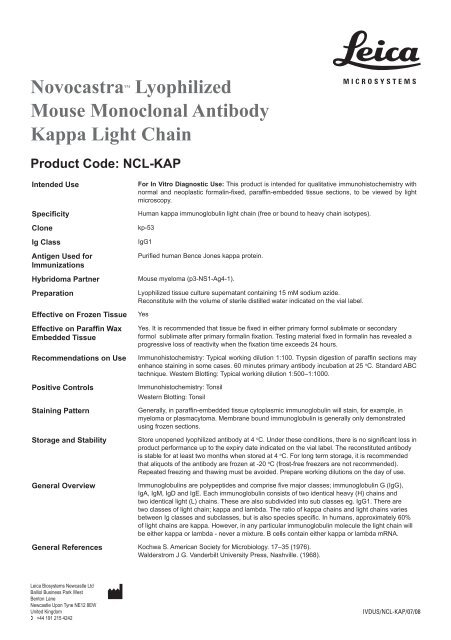Novocastratm Lyophilized Mouse Monoclonal Antibody Kappa ...
Novocastratm Lyophilized Mouse Monoclonal Antibody Kappa ...
Novocastratm Lyophilized Mouse Monoclonal Antibody Kappa ...
Create successful ePaper yourself
Turn your PDF publications into a flip-book with our unique Google optimized e-Paper software.
NovocastraTM <strong>Lyophilized</strong><br />
<strong>Mouse</strong> <strong>Monoclonal</strong> <strong>Antibody</strong><br />
<strong>Kappa</strong> Light Chain<br />
Product Code: NCL-KAP<br />
Intended Use<br />
Specificity<br />
Clone<br />
Ig Class<br />
Antigen Used for<br />
Immunizations<br />
Hybridoma Partner<br />
Preparation<br />
Leica Biosystems Newcastle Ltd<br />
Balliol Business Park West<br />
Benton Lane<br />
Newcastle Upon Tyne NE12 8EW<br />
United Kingdom<br />
( +44 191 215 4242<br />
For In Vitro Diagnostic Use: This product is intended for qualitative immunohistochemistry with<br />
normal and neoplastic formalin-fixed, paraffin-embedded tissue sections, to be viewed by light<br />
microscopy.<br />
Human kappa immunoglobulin light chain (free or bound to heavy chain isotypes).<br />
kp-53<br />
IgG1<br />
Effective on Frozen Tissue Yes<br />
Effective on Paraffin Wax<br />
Embedded Tissue<br />
Recommendations on Use<br />
Positive Controls<br />
Staining Pattern<br />
Storage and Stability<br />
General Overview<br />
General References<br />
Purified human Bence Jones kappa protein.<br />
<strong>Mouse</strong> myeloma (p3-NS1-Ag4-1).<br />
<strong>Lyophilized</strong> tissue culture supernatant containing 15 mM sodium azide.<br />
Reconstitute with the volume of sterile distilled water indicated on the vial label.<br />
Yes. It is recommended that tissue be fixed in either primary formol sublimate or secondary<br />
formol sublimate after primary formalin fixation. Testing material fixed in formalin has revealed a<br />
progressive loss of reactivity when the fixation time exceeds 24 hours.<br />
Immunohistochemistry: Typical working dilution 1:100. Trypsin digestion of paraffin sections may<br />
enhance staining in some cases. 60 minutes primary antibody incubation at 25 o C. Standard ABC<br />
technique. Western Blotting: Typical working dilution 1:500–1:1000.<br />
Immunohistochemistry: Tonsil<br />
Western Blotting: Tonsil<br />
Generally, in paraffin-embedded tissue cytoplasmic immunoglobulin will stain, for example, in<br />
myeloma or plasmacytoma. Membrane bound immunoglobulin is generally only demonstrated<br />
using frozen sections.<br />
Store unopened lyophilized antibody at 4 o C. Under these conditions, there is no significant loss in<br />
product performance up to the expiry date indicated on the vial label. The reconstituted antibody<br />
is stable for at least two months when stored at 4 o C. For long term storage, it is recommended<br />
that aliquots of the antibody are frozen at -20 o C (frost-free freezers are not recommended).<br />
Repeated freezing and thawing must be avoided. Prepare working dilutions on the day of use.<br />
Immunoglobulins are polypeptides and comprise five major classes; immunoglobulin G (IgG),<br />
IgA, IgM, IgD and IgE. Each immunoglobulin consists of two identical heavy (H) chains and<br />
two identical light (L) chains. These are also subdivided into sub classes eg. IgG1. There are<br />
two classes of light chain; kappa and lambda. The ratio of kappa chains and light chains varies<br />
between Ig classes and subclasses, but is also species specific. In humans, approximately 60%<br />
of light chains are kappa. However, in any particular immunoglobulin molecule the light chain will<br />
be either kappa or lambda - never a mixture. B cells contain either kappa or lambda mRNA.<br />
Kochwa S. American Society for Microbiology. 17–35 (1976).<br />
Walderstrom J G. Vanderbilt University Press, Nashville. (1968).<br />
IVDUS/NCL-KAP/07/08
Instructions for Use<br />
Trypsin Digestion for<br />
Immunohistochemical Demonstration on<br />
Paraffin Sections<br />
1.<br />
2.<br />
3.<br />
4.<br />
5.<br />
6.<br />
7.<br />
o Preheat the following to 37 C using a water bath:<br />
(i) 200 mL of TBS<br />
(ii) 200 mL of distilled water.<br />
Dissolve 0.2 g Trypsin 250 and 0.2 g Calcium chloride in the 200 mL of TBS.<br />
o Once the Trypsin solution is at 37 C, pH to 7.8 with 1 M sodium hydroxide.<br />
o Place rehydrated paraffin sections in the distilled water to preheat the sections to 37 C for a minimum of 5 minutes.<br />
o Incubate sections in Trypsin solution at 37 C. The time required will depend on the antibody and tissue, however, 30 minutes is<br />
usually sufficient.<br />
Rinse sections in running tap water.<br />
Proceed with immunohistochemistry protocol.<br />
Reagents Required but not Supplied<br />
50 mM Tris-buffered saline<br />
Trypsin 250: Difco order code 0152–13 (available from Becton Dickinson).<br />
Calcium chloride<br />
1 M Sodium Hydroxide<br />
* Trypsin containing chymotrypsin should always be used. The enzyme activities can vary from a supplier and between batches. Such<br />
variations may affect the incubation time required.<br />
protocol/trypsin/07/08<br />
www.leica-microsystems.com © Leica Microsystems GmbH • HRB 5187 • 95.8150 Rev A

















